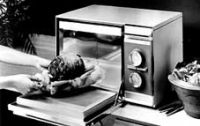Amana Radarange
Amana Refrigeration, a subsidiary of Raytheon Manufacturing Company, in 1967 introduced this first compact microwave oven, called the Radarange. It was a 115 V countertop model, retailing for $495, and cooked hamburgers in 35 seconds. The compact size was made possible by a small, efficient electron tube, developed in 1964 by the Japanese, which replaced older, bulkier tubes called magnetrons. In 1968, tests by Walter Reed Hospital confirmed many fears that microwaves did, in fact, leak out of the ovens, but Federal standards set in 1971 resolved the problem. By 1994, ninety per cent of all US homes had such an appliance. The first microwave ovens for home consumer use were introduced by Tappan in 1955, but few purchased them due to their large size (about like an electric stove) and high cost. Microwave ovens were a spin-off of wartime RADAR, and invented accidentally by Percy LeBaron Spencer of Raytheon while working on a magnetron (radar tube) near the end of the war. As he passed the device, which generated microwaves, he noticed that a candy bar in his pocket began to melt. He experimented with eggs (they exploded) and popcorn (it popped). So, a "high frequency dielectric heating apparatus" was patented in 1945 by Raytheon, and a prototype built. The first microwave oven for commercial purposes (ships and hotels) was introduced in 1947 by Raytheon, and named the Radar Range. It stood five and a half feet tall, weighed 750 pounds, and cost $3000. RADAR (Radio Detection And Ranging) was perfected in the UK by Sir Robert Watson-Watt in 1934 and 1935, who is credited with its invention. It was secretly used by the Allies during World War II, starting in 1940, using a new magnetron (electronic tube) just developed by John Randall and Boot, Henry Albert Howard (1917-1983) British physicist of the UK. Later, an improved magnetron was developed by Percy Spencer of Raytheon in the US, enabling the doubling of production. The concept later known as RADAR was described as early as 1900 by Nikola Tesla (1856-1943), and explored in 1904 by a German, Christian Hülsemeyer. In 1925, the concept was refined by Gregory Breit and Merle Tuve of the US to use pulse modulation.
